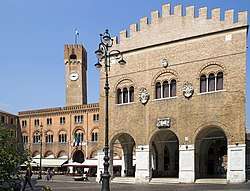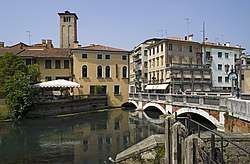Treviso
Treviso (US: /treɪˈviːzoʊ/ tray-VEE-zoh,[3] Italian: [treˈviːzo] (![]()
Treviso | |
|---|---|
| Città di Treviso | |
 | |
 Coat of arms | |
Location of Treviso 
| |
 Treviso Location of Treviso in Italy  Treviso Treviso (Veneto) | |
| Coordinates: 45°40′N 12°15′E | |
| Country | Italy |
| Region | Veneto |
| Province | Treviso (TV) |
| Frazioni | Monigo, San Paolo, Santa Bona, San Pelajo, Santa Maria del Rovere, Selvana, Fiera, Sant'Antonino, San Lazzaro, Sant'Angelo, San Giuseppe, Canizzano |
| Government | |
| • Mayor | Mario Conte (Lega Nord) |
| Area | |
| • Total | 55.5 km2 (21.4 sq mi) |
| Elevation | 15 m (49 ft) |
| Population (30 September 2017)[2] | |
| • Total | 84,669 |
| • Density | 1,500/km2 (4,000/sq mi) |
| Demonym(s) | Trevigiani or Trevisani |
| Time zone | UTC+1 (CET) |
| • Summer (DST) | UTC+2 (CEST) |
| Postal code | 31100 |
| Dialing code | 0422 |
| ISTAT code | 026086 |
| Patron saint | St. Liberalis |
| Saint day | 27 April |
| Website | Official website |
The city is home to the headquarters of clothing retailer Benetton, Sisley, Stefanel, Geox, Diadora and Lotto Sport Italia, appliance maker De'Longhi, and bicycle maker Pinarello.
Treviso is also known for being the original production area of Prosecco wine and radicchio,[5][6] and is thought to have been the origin of the popular Italian dessert Tiramisù.[7]
History
Ancient era
Some believe that Treviso derived its name from the Celtic word "tarvos" mixed with the Latin ending "isium" forming "Tarvisium". Others believe it comes from a word from the language of a tribe who first came to Treviso.[8]
Tarvisium, then a city of the Veneti, became a municipium in 89 BC after the Romans added Cisalpine Gaul to their dominions. Citizens were ascribed to the Roman tribe of Claudia. The city lay in proximity of the Via Postumia, which connected Opitergium to Aquileia, two major cities of Roman Venetia during Ancient and early medieval times. Treviso is rarely mentioned by ancient writers, although Pliny writes of the Silis, that is the Sile River, as flowing ex montibus Tarvisanis.
During the Roman period, Christianity spread to Treviso. Tradition records that St. Prosdocimus, a Greek who had been ordained bishop by St. Peter, brought the Catholic faith to Treviso and surrounding areas. By the 4th century, the Christian population grew sufficient to merit a resident bishop. The first documented bishop was John the Pious[9] who began his episcopacy in 396 AD.
Early Middle Ages
Treviso went through a demographic and economic decline similar to the rest of Italy after the fall of the Western Empire; however, it was spared by Attila the Hun, and thus, remained an important center during the 6th century. According to tradition, Treviso was the birthplace of Totila, the leader of Ostrogoths during the Gothic Wars. Immediately after the Gothic Wars, Treviso fell under the Byzantine Exarchate of Ravenna until 568 AD when it was taken by the Lombards, who made it one of 36 ducal seats and established an important mint. The latter was especially important during the reign of the last Lombard king, Desiderius, and continued to churn out coins when northern Italy was annexed to the Frankish Empire. People from the city also played a role in the founding of Venice.
Charlemagne made it the capital of a border march, i.e. the Marca Trevigiana, which lasted for several centuries.
Middle Ages
Treviso joined the Lombard League, and gained independence after the Peace of Constance (1183).[10] This lasted until the rise of seignories in northern Italy. In 1214, Treviso was the scene of the Castle of Love that turned into a war between Padua and Venice. Among the various families who ruled over Treviso, the Da Romano reigned from 1237 to 1260. Struggles between Guelph and Ghibelline factions followed, with the first triumphant in 1283 with Gherardo III da Camino, after which Treviso experienced significant economic and cultural growth which continued until 1312. Treviso and its satellite cities, including Castelfranco Veneto (founded by the Trevigiani in contraposition to Padua), had become attractive to neighbouring powers, including the da Carrara and Scaligeri. After the fall of the last Caminesi lord, Rizzardo IV, the Marca was the site of continuous struggles and ravages (1329–1388).
Treviso notary and physician Oliviero Forzetta was an avid collector of antiquities and drawings; the collection was published in a catalog in 1369, the earliest such catalog to survive to this day.[11]
Venetian rule
After a Scaliger domination in 1329–1339, the city gave itself to the Republic of Venice,[10] becoming the first notable mainland possession of the Serenissima. From 1318 it was also, for a short time, the seat of a university. Venetian rule brought innumerable benefits; however, Treviso necessarily became involved in the wars of Venice. From 1381–1384, the city was captured and ruled by the duke of Austria, and then by the Carraresi until 1388. Having returned to Venice, the city was fortified and given a massive line of walls and ramparts, still existing; these were renewed in the following century under the direction of Fra Giocondo, two of the gates being built by the Lombardi. The many waterways were exploited with several waterwheels which mainly powered mills for milling grain produced locally. The waterways were all navigable and "barconi" would arrive from Venice at the Port of Treviso (Porto de Fiera) pay duty and offload their merchandise and passengers along Riviera Santa Margherita. Fishermen were able to bring fresh catch every day to the Treviso fish market, which is held still today on an island connected to the rest of the city by two small bridges at either end.
French and Austrian rule
Treviso was taken in 1797 by the French under Mortier, who was made duke of Treviso. French domination lasted until the defeat of Napoleon, after which it passed to the Austro-Hungarian Empire. The citizens, still at heart loyal to the fallen Venetian Republic, were displeased with imperial rule and in March 1848, drove out the Austrian garrison. However, after the town was bombarded, the people were compelled to capitulate in the following 14 June. Austrian rule continued until Treviso was annexed with the rest of Veneto to the Kingdom of Italy in 1866.[12]
19th century and later
During World War I, Treviso held a strategic position close to the Austrian front. Just north, the Battle of Vittorio Veneto helped turn the tide of the War.
During World War II, one of several Italian concentration camps was established for Slovene and Croatian civilians from the Province of Ljubljana in Monigo, near Treviso. The Monigo camp was disbanded with the Italian capitulation in 1943.
The city suffered several bombing raids during World War II.[13] A large part of the medieval structures of the city center were destroyed—including part of the Palazzo dei Trecento, later rebuilt—causing the death of about 1,600 people.[14]
In January 2005, a bomb enclosed in a candy egg and attributed to the so-called Italian Unabomber detonated on a Treviso street.[15]
Geography

Treviso stands at the confluence of Botteniga with the Sile,[10] 30 kilometres (19 miles) north of Venice, 50 km (31 mi) east of Vicenza, 40 km (25 mi) north-east of Padua, and 120 km (75 mi) south of Cortina d'Ampezzo. The city is situated some 15 km (9 mi) south-west the right bank of the Piave River, on the plain between the Gulf of Venice and the Alps.
Climate
Climate in Treviso has mild differences between highs and lows, and has adequate rainfall year-round. The Köppen Climate Classification subtype for this climate is "Cfa" (temperate Humid subtropical climate).[16]
| Climate data for Treviso, Italy | |||||||||||||
|---|---|---|---|---|---|---|---|---|---|---|---|---|---|
| Month | Jan | Feb | Mar | Apr | May | Jun | Jul | Aug | Sep | Oct | Nov | Dec | Year |
| Average high °C (°F) | 7 (44) |
9 (48) |
13 (56) |
17 (63) |
22 (72) |
26 (78) |
28 (83) |
28 (82) |
24 (76) |
19 (66) |
12 (54) |
7 (45) |
18 (64) |
| Average low °C (°F) | −2 (29) |
−1 (31) |
3 (38) |
7 (45) |
12 (53) |
16 (60) |
17 (63) |
17 (62) |
14 (57) |
9 (48) |
3 (38) |
−1 (31) |
8 (47) |
| Average precipitation mm (inches) | 66 (2.6) |
64 (2.5) |
71 (2.8) |
69 (2.7) |
89 (3.5) |
100 (4.1) |
66 (2.6) |
91 (3.6) |
76 (3) |
81 (3.2) |
86 (3.4) |
64 (2.5) |
930 (36.5) |
| Average precipitation days | 6.3 | 6.2 | 7.1 | 8.6 | 9.6 | 9.4 | 6.9 | 7.3 | 6.2 | 6.4 | 7.4 | 6.5 | 87.9 |
| Source: Weatherbase[17] | |||||||||||||
Government
Architecture
- The Late Romanesque–Early Gothic church of San Francesco, built by the Franciscan community in 1231–1270. Used by Napoleonic troops as a stable, it was reopened in 1928. The interior has a single nave with five chapels. On the left wall is a Romanesque-Byzantine fresco portraying St. Christopher (later 13th century). The Grand Chapel has a painting of the Four Evangelists by a pupil of Tommaso da Modena, to whom is instead directly attributed a fresco of Madonna with Child and Seven Saints (1350) in the first chapel on the left. The next chapel has instead a fresco with Madonna and Four Saints from 1351 by the so-called Master of Feltre. The church, among others, houses the tombs of Pietro Alighieri, son of Dante, and Francesca Petrarca, daughter of the poet Francesco.
- The Loggia dei Cavalieri, an example of Treviso's Romanesque influenced by Byzantine forms. It was built under the podestà Andrea da Perugia (1276) as a place for meetings, talks and games, although reserved only to the higher classes.
- Piazza dei Signori (Lords' Square), with the Palazzo di Podestà (later 15th century).
- Church of San Nicolò, a mix of 13th-century Venetian Romanesque and French Gothic elements. The interior has a nave and two aisles, with five apsed chapels. It houses important frescoes by Tommaso da Modena, depicting St Romuald, St Agnes and the Redemptor and St Jerome in his Study. Also the Glorious Mysteries of Santo Peranda can be seen. Noteworthy is also the fresco of St Christopher on the eastern side of the church, which is the most ancient depiction in glass in Europe.
- Cathedral is dedicated to St Peter. It was once a small church built in the Late Roman era, to which later were added a crypt and the Santissimo and Malchiostro Chapels (1520). After the numerous later restorations, only the gate remains of the original Roman edifice. The interior houses works by Il Pordenone and Titian (Malchiostro Annunciation) among others. The edifice has seven domes, five over the nave and two closing the chapels.
- Palazzo dei Trecento, built in the 13th–14th centuries.
- Piazza Rinaldi. It is the seat of three palaces of the Rinaldi family, the first built in the 12th century after their flight from Frederick Barbarossa. The second, with unusual ogival arches in the loggia of the first floor, is from the 15th century. The third was added in the 18th century.
- Ponte di Pria (Stone Bridge), along the city walls, where River Botteniga divides into the three channels that cross the city centre (Cagnan Grande, Cagnan di Mezzo, Roggia).
- Monte di Pietà di Treviso and the Cappella dei Rettori. The Monte di Pietà was founded to house Jewish moneylenders. On the second floor is the Cappella dei Rettori, a lay hall for meetings, with frescoes by il Pozzoserrato.
- Teatro Mario Del Monaco, the main theatre and opera house of the city. It was built in 1869 to designs by Andrea Scala which kept the theatre's original facade. The internal decorations were by the painter Federico Andreotti and the sculptor Fausto Asteo.[18]
Parks and gardens
Sports
Treviso is home to several notable Italian sport teams, thanks to the presence of the Benetton family, who owns and sponsors:
- Sisley Treviso (volleyball), winner of 9 scudetti, playing at the Palaverde.
- Benetton (rugby union), winner of 15 scudetti, playing at the Monigo stadium. Since the 2010–11 season, Benetton has been one of two Italian teams in the Pro14, alongside existing teams from Ireland, Scotland, and Wales.
- Benetton Basket, winner of 5 scudetti, playing at the Palaverde.
The local football team, A.S.D. Treviso 2009, played for the first time in the Italian Serie A in 2005. Its home stadium is the Omobono Tenni.
Treviso is a popular stop on the professional cyclo-cross racing circuit and served as the site of the 2008 UCI Cyclo-cross World Championships.
Treviso is a popular area for cycling enthusiasts. From the city center there is an cycling path along the Sile river with connecting paths all the way to Jesolo, a seaside resort on the Adriatic sea. For road cyclists, Treviso is also a starting/finishing point for tours to the Montello hill and further into the hills of the area around Conegliano and Valdobbiadene.
Transportation
Treviso Centrale railway station has Trenitalia trains to Venice, Padua, Belluno, Portogruaro, Vicenza, Udine and Trieste.
Treviso Airport, west of the city, specializes in low cost airlines.
MOM is the major transport company in the city and provides for urban and suburban services in the Province of Treviso.
Notable people
- Baduila, Ostrogothic king (ruled 541–552)
- Luciano Benetton (born 13 May 1935), chairman of the Benetton Group
- Gloria Aura Bortolini (born 1982); journalist, photographer and filmmaker
- Mario Botter (1896–1978); frescos restorer, superintended of monuments, art writer
- Angelo Ephrikian (1913–1982), musicologist and violinist
- Antonino Rocca (1921-1977), professional wrestler
- Laura Efrikian (born 1940), actress and television personality
- Giuliano Carmignola (born 1951), violinist
- Leonora Fani (born 1954), film actor
- Marco Paolini (born 1956), stage actor
- Giovanni Masutto (1830–1894), musicologist and flautist,
- Marius Mitrea, (born 1982), 2015 Rugby World Cup secondary referee
- Diletta Rizzo Marin (born 1984), opera singer and model
- Alessandro Del Piero (born 1974), World Cup winning footballer
International relations
Twin towns – Sister cities
Treviso is twinned with:
See also
- Treviso Arithmetic, a textbook of commercial mathematics published by an anonymous author in the 15th century
References
![]()
- "Superficie di Comuni Province e Regioni italiane al 9 ottobre 2011". Istat. Retrieved 16 March 2019.
- "Popolazione Residente al 1° Gennaio 2018". Istat. Retrieved 16 March 2019.
- "Treviso". Merriam-Webster Dictionary. Retrieved 1 August 2019.
- "Data at Istat website". Archived from the original on 23 April 2011. Retrieved 15 May 2011.
- Kafka, Barbara (21 December 1988). "Radicchio: Tasty but So Misunderstood". The New York Times. Archived from the original on 24 October 2017. Retrieved 11 May 2017.
The radicchio that Italians eat most often is Treviso.
- Pavan, Camillo (2013). Sull'origine del radicchio rosso di Treviso: La leggenda di Van den Borre e la scoperta di Tiziano Tempesta. Treviso. p. 6.
- online, Redazione. "Crisi, chiude il ristorante dove nacque la prima ricetta del "Tiramisù"". Corriere del Veneto (in Italian). Archived from the original on 21 September 2018. Retrieved 20 September 2018.
- "Storia di Treviso". Comune di Treviso. 17 August 2008. Archived from the original on 22 September 2018. Retrieved 22 September 2018.
- "Chronotaxis". Diocesi di Treviso (in Italian). Diocese of Treviso. Archived from the original on 3 March 2016. Retrieved 15 September 2011.
- Britannica 1910.
- Taylor, F. H. (1948). The Taste of Angels: a history of art collecting from Rameses to Napoleon Archived 11 April 2016 at the Wayback Machine. Boston: Little, Brown. p. 43. Retrieved 13 September 2014.
- See Wikipedia page Veneto
- Migliorini, Elio; Lavagnino, Emilio. "TREVISO". Enciclopedia Italiana di Scienze, Lettere ed Arti. Archived from the original on 21 September 2018. Retrieved 20 September 2018.
- La mostra Treviso il 7 aprile 1944
- Popham, Peter (27 January 2005). "Italian 'Unabomber' uses child's chocolate egg to hide explosive". The Independent. Archived from the original on 25 September 2015. Retrieved 13 September 2014.
- "Climate Summary for Treviso, Italy". Archived from the original on 22 September 2015. Retrieved 19 June 2013.
- "Weatherbase.com". Weatherbase. 2013. Archived from the original on 23 October 2013. Retrieved 19 June 2013.
- Lynn, Karyl Charna (2005). Italian Opera Houses and Festivals, pp. 75–78. Scarecrow Press. ISBN 1461706785
- "comuni-italiani.it". Archived from the original on 14 June 2014. Retrieved 3 June 2014.
- "Câmara recebe delegação sul-coreana". CÂMARA MUNICIPAL CURITIBA (in Portuguese). Câmara Municipal de Curitiba. 24 July 2007. Archived from the original on 21 September 2018. Retrieved 21 September 2018.
Bibliography
"Treviso", Encyclopædia Britannica (11th ed.), New York, 1910, OCLC 14782424 – via Internet Archive
External links
| Wikimedia Commons has media related to Treviso. |
| Wikivoyage has a travel guide for Treviso. |